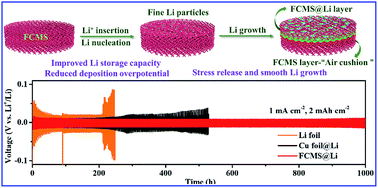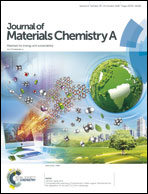Favorable lithium deposition behaviors on flexible carbon microtube skeleton enable a high-performance lithium metal anode†
Abstract
Problems involving dendritic lithium (Li) growth and infinite volume change indeed hinder the practical applications of high-energy-density Li metal batteries. Herein, we adopted the flexible carbon microtube skeleton (FCMS) as a lightweight and easily obtained 3D current collector to accommodate metallic Li. The stable intercalation and electrodeposition behavior on the FCMS greatly improves the Li storage capacity and cycling stability, accompanying reduced Li deposition overpotential. Moreover, Li metal was found to predominantly grow inside the upper layer of the FCMS owing to the faster electron transport than Li+ diffusion, whereas the lower layer of the FCMS without metallic Li serves as a soft and conductive “air cushion”, which can significantly suppress the Li dendrite growth based on the stress relief mechanism. Benefiting from such favorable Li deposition behaviors, the FCMS electrode maintains a steady and high CE (∼98%) for nearly 1400 h with an ultrahigh areal capacity (10 mA h cm−2). With the existence of FCMS, the composite Li anode presents a tiny and stable voltage hysteresis of ∼50 mV even at 5 mA cm−2 for 5 mA h cm−2. The FCMS@Li based full cell with LiFePO4 as cathode (9.4 mg cm−2) delivers enhanced cycling stability, coulombic efficiencies and rate capability (∼120 mA h g−1 at 5 C with ultralow overpotential). These favorable Li deposition behaviors on FCMS might provide some inspiration for the future design of high-performance composite Li metal anodes.



 Please wait while we load your content...
Please wait while we load your content...